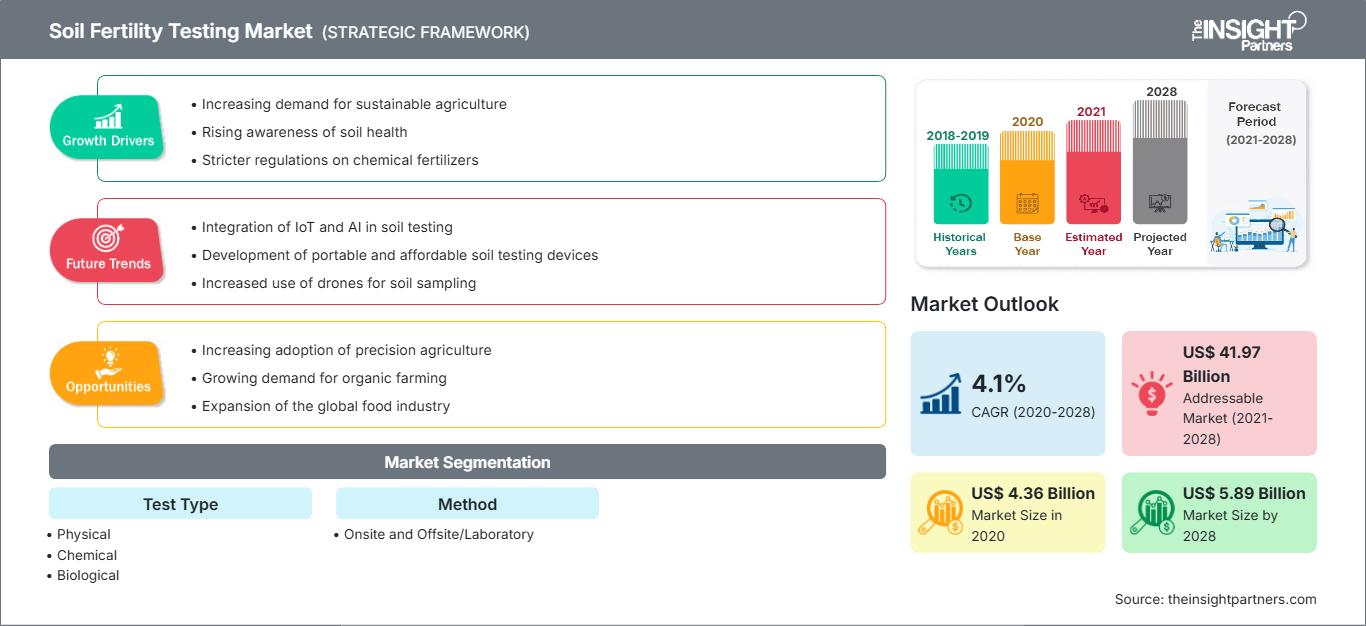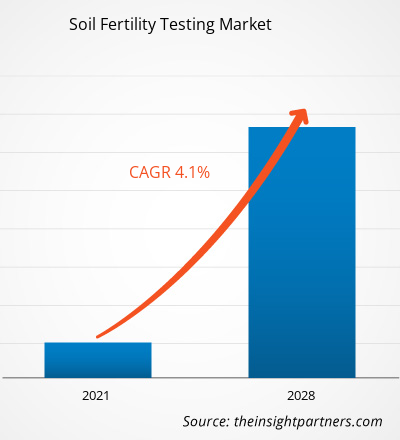2020年,土壤肥力测试市场价值为43.5551亿美元,预计到2028年将达到58.9106亿美元;预计2021年至2028年的复合年增长率为4.1%。
土壤肥力测试有助于确定土壤的生长潜力,可以指示养分不足、肥力过剩导致的潜在毒性以及非必需微量矿物质造成的抑制。测试结果还可用于确定是否需要模拟根系吸收矿物质的能力。
预计亚太地区土壤肥力测试市场在预测期内将以最高的复合年增长率增长。该地区市场的增长主要归因于对优质农产品和原料的需求增长,以及中国和印度农业实践的快速进步。日本是该地区土壤肥力测试市场增长的另一个重要贡献者。
自定义此报告以满足您的要求
您将免费获得任何报告的定制,包括本报告的部分内容,或国家级分析、Excel 数据包,以及为初创企业和大学提供超值优惠和折扣
土壤肥力测试市场: 战略洞察

-
获取本报告的主要市场趋势。这个免费样本将包括数据分析,从市场趋势到估计和预测。
新冠疫情对土壤肥力检测市场的影响
新冠疫情爆发扰乱了土壤肥力检测市场,原因包括农业活动放缓、供应链不稳定、贸易流动受限以及劳动力供应减少等。疫情导致国内外边界突然关闭,从而扭曲了运营效率并扰乱了价值链。然而,随着各经济体计划恢复运营,预计未来几个月全球对土壤肥力检测的需求将会上升。此外,由于新冠病例数量的增加,对健康粮食作物、水果和蔬菜以及营养丰富、增强免疫力的食品的需求也在增加,这将支持土壤肥力检测市场的增长。此外,在疫情期间,印度、孟加拉国和越南等农业国家受到的打击最为严重,这些国家的农业占GDP的12%至16%。尽管各国政府宣布了针对小农户的救助计划和一揽子计划,但农业部门的表现一直在下滑。加州供应着美国近三分之一的水果和蔬菜,但2020年疫情激增导致加州的农产品供应受到限制,这阻碍了美国土壤肥力检测市场的增长。
市场洞察:政府对作物营养成分的严格监管促进了燃料土壤肥力检测市场的增长
施用肥料,尤其是合成肥料,会向大气中释放有害气体,从而危害环境。因此,各国都制定了多项规定,禁止向大气中排放此类有害气体。例如,美国食品药品监督管理局 (FDA) 负责监管在州际贸易中销售的国产和进口食品;确保食品的安全、卫生、营养成分、完整性以及产品标签的适用性。此外,《农业经营条例》(2002)旨在解决农业活动造成的面源污染问题,确保土壤磷的有效平衡,以保持土壤肥力并减少过量施用粪肥造成的损失。该条例还涵盖了牲畜结构和粪肥管理标准,以及限制水污染的土地使用法规。此外,美国、加拿大、澳大利亚和欧盟等国家高度重视监测政策框架及其严格执行,以提高供应链透明度并确保可追溯性。这些措施确保受感染的食品、饲料和农产品在边境被拒收,并在通关前进行适当处理,以便进一步在国内分销。违规者将被处以高额罚款或/和吊销其许可证。因此,为了满足各监管机构制定的安全和质量要求,农业产量测试正越来越多地被用作预防措施。土壤肥力测试提供有关土壤健康和作物所需适当营养的信息,以及有关施用于土壤的化学品及其对土壤影响的信息。土壤污染预计将对当地生态环境造成不利影响,包括植物和人类。土壤中的有毒物质会降低土壤肥力,降低土壤产量。如果用这样的土壤种植水果和蔬菜,产量将缺乏关键营养成分,并可能含有可能引起严重健康问题的危险化合物。此外,在出口时,必须检查作物的营养价值,以确保其符合各国政府的规定。进行土壤肥力测试就是为了避免此类后果。因此,政府对食品营养成分的严格监管刺激了土壤肥力测试市场的增长。
测试类型洞察
根据测试类型,土壤肥力测试市场可分为物理、化学和生物测试。化学测试在2020年占据了最大的市场份额,预计在预测期内将实现最高的复合年增长率。化学土壤测试已成为避免向农场系统输入过多营养物质的监测工具。这些测试有助于确定植物必需营养素(如磷、氮、钾、有效石灰、有机质、硫和微量元素)的浓度,以及其他物理特性(如容量、渗透性、密度和 pH 值)。此外,土壤化学测试有助于优化作物生产,保护环境免受过量肥料径流和淋溶造成的污染,诊断植物栽培问题,并增强生长介质的营养平衡。
方法洞察
根据方法,土壤肥力测试市场分为现场和异地/实验室。异地/实验室部分在 2020 年占据了更大的市场份额,预计在预测期内将实现更高的市场复合年增长率。异地土壤测试方法包括有机质水平、显微镜检查、生物活动、熏蒸和分子方法。在实验室中,原子吸收光谱仪、电感耦合等离子体光谱仪 (ICP)、拉查特流动注射分析仪、比色计和其他实验室设备用于检测土壤肥力。土壤肥力测试的实验室方法可以提供有关土壤状况和管理、土壤肥力管理、减少肥料支出的必要性以及避免过度施肥和防止土壤退化的方法的知识。
土壤肥力测试市场的一些主要参与者包括 SGS SA、Eurofins Scientific、ALS Limited、Agrolab GmbH、Actlabs、Agrocares、Water Agriculture Laboratories, Inc.、Polytest Laboratories、Crop Nutrition Laboratory Services Ltd. 和 A and L Great Lakes。这些关键公司实施并购和研发战略,以扩大客户群并在全球市场中获得显著份额,这也使他们能够在全球范围内维护自己的品牌。
土壤肥力检测市场
The Insight Partners 的分析师已详尽阐述了预测期内影响土壤肥力测试市场的区域趋势和因素。本节还讨论了北美、欧洲、亚太地区、中东和非洲以及南美和中美洲的土壤肥力测试市场细分和地理分布。
土壤肥力测试市场报告范围
| 报告属性 | 细节 |
|---|---|
| 市场规模 2020 | US$ 4.36 Billion |
| 市场规模 2028 | US$ 5.89 Billion |
| 全球复合年增长率 (2020 - 2028) | 4.1% |
| 历史数据 | 2018-2019 |
| 预测期 | 2021-2028 |
| 涵盖的领域 |
By 测试类型
|
| 覆盖地区和国家 |
北美
|
| 市场领导者和主要公司简介 |
|
土壤肥力测试市场参与者密度:了解其对业务动态的影响
土壤肥力检测市场正在快速增长,这得益于终端用户需求的不断增长,而这些需求的驱动因素包括消费者偏好的演变、技术进步以及对产品优势的认知度不断提高。随着需求的增长,企业正在扩展其产品线,不断创新以满足消费者需求,并抓住新兴趋势,从而进一步推动市场增长。

- 获取 土壤肥力测试市场 主要参与者概述
- 土壤肥力测试市场中的渐进式行业趋势,帮助参与者制定有效的长期战略
- 公司为确保在发达和发展中市场的增长而采取的业务增长战略
- 2019 年至 2028 年土壤肥力测试市场的定量分析
- 全球土壤肥力测试需求估计
- PEST 分析,以说明行业中买家和供应商的有效性
- 了解竞争激烈的市场形势的最新发展
- 市场趋势和前景以及推动和抑制土壤肥力测试市场增长的因素
- 通过强调支撑商业利益的市场策略来协助决策过程,从而促进市场增长
- 不同节点的土壤肥力测试市场规模
- 市场的详细概述和细分,以及土壤肥力测试行业动态
- 土壤肥力测试市场的大小
土壤肥力测试市场 - 按测试类型
- 物理
- 化学
- 生物
土壤肥力测试市场 - 按方法
- 现场
- 场外/实验室
公司简介
- SGS SA
- Eurofins Scientific
- ALS Limited
- Agrolab GMBH
- Actlabs
- Agrocares
- Waters Agricultural Laboratories Inc
- Polytest Laboratories
- Crop Nutrition Laboratory Services Ltd.
- A and L Great Lakes
- 历史分析(2 年)、基准年、预测(7 年)及复合年增长率
- PEST和SWOT分析
- 市场规模、价值/数量 - 全球、区域、国家
- 行业和竞争格局
- Excel 数据集
近期报告
相关报告
客户评价
购买理由
- 明智的决策
- 了解市场动态
- 竞争分析
- 客户洞察
- 市场预测
- 风险规避
- 战略规划
- 投资论证
- 识别新兴市场
- 优化营销策略
- 提升运营效率
- 顺应监管趋势






















 获取免费样品 - 土壤肥力测试市场
获取免费样品 - 土壤肥力测试市场